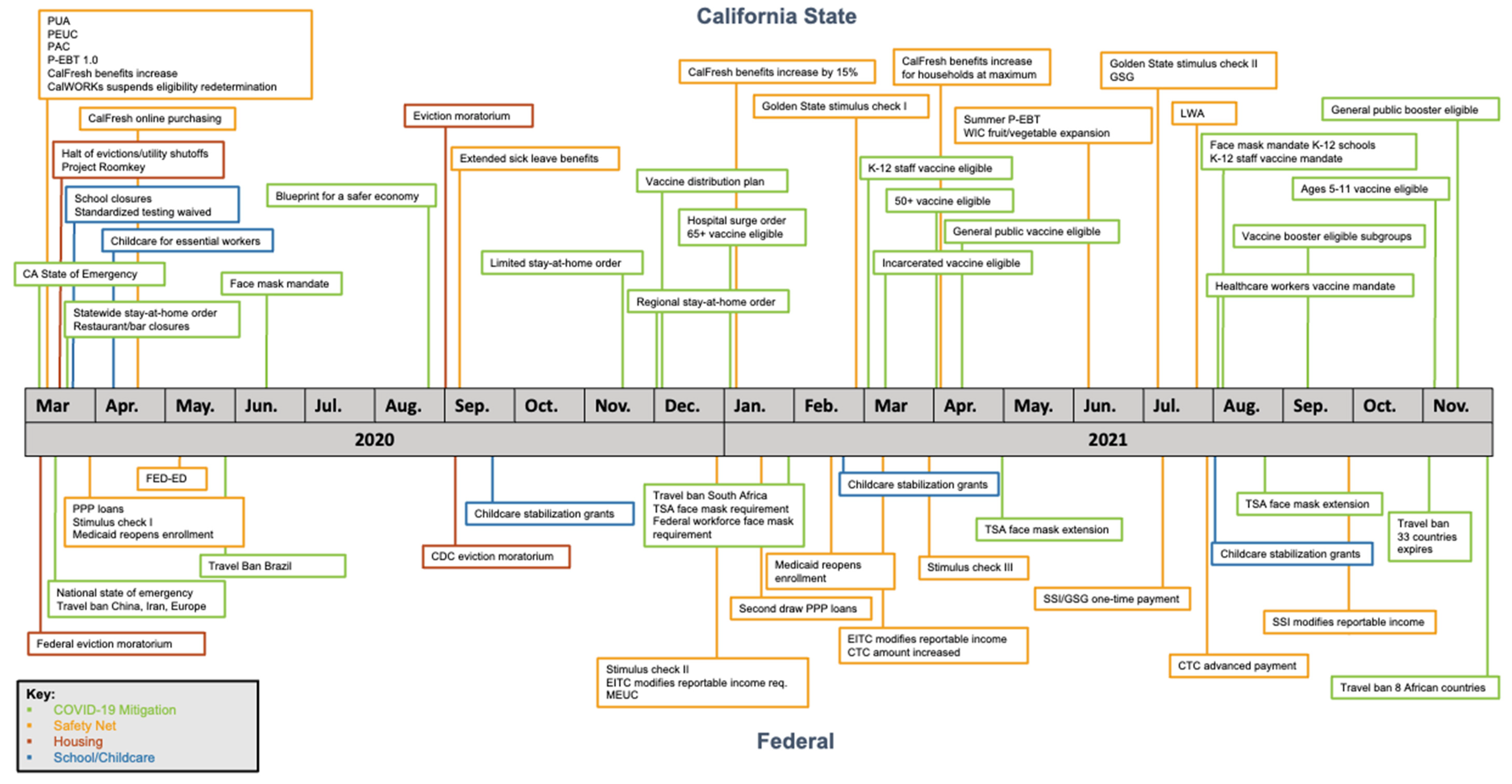Characterizing the Landscape of Safety Net Programs and Policies in California during the COVID-19 Pandemic
Abstract
:1. Introduction
2. Materials and Methods
3. Results
4. Discussion
Limitations
5. Conclusions
Supplementary Materials
Author Contributions
Funding
Institutional Review Board Statement
Informed Consent Statement
Data Availability Statement
Conflicts of Interest
References
- California’s Commitment to Health Equity. Available online: https://covid19.ca.gov/equity/ (accessed on 5 January 2022).
- Anderson, A. Women and People of Color Take Biggest Hits in California’s Job Losses; California Budget & Policy Center: Sacramento, CA, USA, 2020. [Google Scholar]
- Fischer, C.B.; Adrien, N.; Silguero, J.J.; Hopper, J.J.; Chowdhury, A.I.; Werler, M.M. Mask adherence and rate of COVID-19 across the United States. PLoS ONE 2021, 16, e0249891. [Google Scholar] [CrossRef] [PubMed]
- Marroquin, B.; Vine, V.; Morgan, R. Mental health during the COVID-19 pandemic: Effects of stay-at-home policies, social distancing behavior, and social resources. Psychiatry Res. 2020, 293, 113419. [Google Scholar] [CrossRef] [PubMed]
- Shields-Zeeman, L.; Collin, D.F.; Batra, A.; Hamad, R. How does income affect mental health and health behaviours? A quasi-experimental study of the earned income tax credit. J. Epidemiol. Community Health 2021, 75, 929–935. [Google Scholar] [CrossRef] [PubMed]
- Molitor, F.; Doerr, C. Very Low Food Security Among Low-Income Households with Children in California Before and Shortly After the Economic Downturn From COVID-19. Prev. Chronic Dis. 2021, 18, E01. [Google Scholar] [CrossRef]
- Hale, T.; Angrist, N.; Goldszmidt, R.; Kira, B.; Petherick, A.; Phillips, T.; Webster, S.; Cameron-Blake, E.; Hallas, L.; Majumdar, S.; et al. A global panel database of pandemic policies (Oxford COVID-19 Government Response Tracker). Nat. Hum. Behav. 2021, 5, 5299–5538. [Google Scholar] [CrossRef] [PubMed]
- Raifman, J.N.K.; Jones, D.; Bor, J.; Lipson, S.; Jay, J.; Chan, P. COVID-19 US State Policy Database. Available online: www.tinyurl.com/statepolicies (accessed on 13 September 2021).
- Census: Racial and Ethnic Diversity Index by State. 2020. Available online: https://www.census.gov/library/visualizations/2021/dec/racial-and-ethnic-diversity-index.html (accessed on 6 February 2022).
- California Implements First-in-the-Nation Measure to Encourage Teachers and School Staff to Get Vaccinated. Available online: https://www.gov.ca.gov/2021/08/11/california-implements-first-in-the-nation-measure-to-encourage-teachers-and-school-staff-to-get-vaccinated/ (accessed on 6 January 2022).
- Benefit Increases Because of COVID-19. Available online: http://calfresh.guide/benefit-increase-because-of-covid-19/ (accessed on 6 January 2022).
- Bohn, S.; Danielson, C.; Thorman, T. Poverty in California; Public Policy Institute of California: San Francisco, CA, USA, 2019. [Google Scholar]
- Berenson, J.; Yan, L.; Lynch, J.; Pagán, J.A. Identifying Policy Levers and Opportunities For Action Across States to Achieve Health Equity. Health Aff. 2017, 36, 1048–1056. [Google Scholar] [CrossRef] [PubMed]
- The Internet Archive the Wayback Machine. Available online: https://web.archive.org/ (accessed on 13 May 2021).
- Raifman, J.; Bor, J.; Venkataramani, A. Association Between Receipt of Unemployment Insurance and Food Insecurity Among People Who Lost Employment During the COVID-19 Pandemic in the United States. JAMA Netw. Open 2021, 4, e2035884. [Google Scholar] [CrossRef] [PubMed]
- Gregory Acs, M.K. Employment, Income, and Unemployment Insurance during the COVID-19 Pandemic; Urban Institute: Washington, DC, USA, 2020. [Google Scholar]
- Collins, C.; Landivar, L.C.; Ruppanner, L.; Scarborough, W.J. COVID-19 and the Gender Gap in Work Hours. Gend. Work. Organ. 2020, 28, 101–112. [Google Scholar] [CrossRef] [PubMed]
- Berkowitz, S.A.; Basu, S. Unmet Social Needs and Worse Mental Health After Expiration Of COVID-19 Federal Pandemic Unemployment Compensation. Health Aff. 2021, 40, 426–434. [Google Scholar] [CrossRef] [PubMed]
- Matthay, E.C.; Hagan, E.; Joshi, S.; Tan, M.L.; Vlahov, D.; Adler, N.; Glymour, M.M. The revolution will be hard to evaluate: How co-occurring policy changes affect research on the health effects of social policies. Epidemiol. Rev. 2021, 43, 19–32. [Google Scholar] [CrossRef] [PubMed]
- Food, D.G.E. Tracking the COVID-19 Recession’s Effects on Food, Housing, and Employment Hardships; Center on Budget and Policy Priorities: Washington, DC, USA, 2021. [Google Scholar]
- Bianchi, F.; Bianchi, G.; Song, D. The Long-Term Impact of the COVID-19 Unemployment Shock on Life Expectancy and Mortality Rates; Working paper 18304; National Bureau of Economic Research: Cambridge, MA, USA, 2021. [Google Scholar]
- Been, J.V.; Burgos Ochoa, L.; Bertens, L.C.M.; Schoenmakers, S.; Steegers, E.A.P.; Reiss, I.K.M. Impact of COVID-19 mitigation measures on the incidence of preterm birth: A national quasi-experimental study. Lancet Public Health 2020, 5, e604–e611. [Google Scholar] [CrossRef]


Publisher’s Note: MDPI stays neutral with regard to jurisdictional claims in published maps and institutional affiliations. |
© 2022 by the authors. Licensee MDPI, Basel, Switzerland. This article is an open access article distributed under the terms and conditions of the Creative Commons Attribution (CC BY) license (https://creativecommons.org/licenses/by/4.0/).
Share and Cite
Jackson, K.E.; Yeb, J.; Gosliner, W.; Fernald, L.C.H.; Hamad, R. Characterizing the Landscape of Safety Net Programs and Policies in California during the COVID-19 Pandemic. Int. J. Environ. Res. Public Health 2022, 19, 2747. https://doi.org/10.3390/ijerph19052747
Jackson KE, Yeb J, Gosliner W, Fernald LCH, Hamad R. Characterizing the Landscape of Safety Net Programs and Policies in California during the COVID-19 Pandemic. International Journal of Environmental Research and Public Health. 2022; 19(5):2747. https://doi.org/10.3390/ijerph19052747
Chicago/Turabian StyleJackson, Kaitlyn E., Joseph Yeb, Wendi Gosliner, Lia C. H. Fernald, and Rita Hamad. 2022. "Characterizing the Landscape of Safety Net Programs and Policies in California during the COVID-19 Pandemic" International Journal of Environmental Research and Public Health 19, no. 5: 2747. https://doi.org/10.3390/ijerph19052747
APA StyleJackson, K. E., Yeb, J., Gosliner, W., Fernald, L. C. H., & Hamad, R. (2022). Characterizing the Landscape of Safety Net Programs and Policies in California during the COVID-19 Pandemic. International Journal of Environmental Research and Public Health, 19(5), 2747. https://doi.org/10.3390/ijerph19052747








